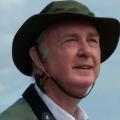
Our Wild Things columnist Eric Brown explains why it always pays dividends to keep searching for rare wildlife even after it seems you have hit your target.
My mobile telephone has a habit of demanding attention at the most inconvenient moments. When this happened on September 7, I sighed wearily and reached for the instrument.
My lethargy vanished as I read a text saying: "Whinchat at Upper College Farm."
Wild Things: Small is beautiful with this mini bird guide
The message came from Bexley's birdfinder-general Ian Stewart, tipping me off to the nearby presence of an appealing bird worth seeing each year.
Whinchats only pass through south London on inward migration in spring and outward migration in autumn, so the window of opportunity is limited.
At this point, I will remind readers that Ian Stewart is the Sidcup-based birder who has discovered a string of local rarities including a little bunting last December which drew enthusiasts from all over London to see it well into January.
Now he had a whinchat in exactly the same field! On site in less than half an hour, my binoculars revealed no small birds and no birders.
I started on the downhill path when a squeak of bicycle brakes behind me revealed Ian had arrived to help my search. He pointed out where he'd seen the bird but several more scans failed to locate it.
We walked on, continuing to scan without success. In these circumstances it can be easy to lose focus and I had locked on to an over-flying kestrel when Ian growled: "Whinchat."

Perched atop a sapling emerging from long grass was a superb bird with bold white eyestripe, apricot breast and subtly-lined brown back. What a cracker.
It disappeared as we moved slowly forwards but then suddenly popped up again on a bush just 30 yards away. A second whinchat was now with it and another, darker and smaller, bird flicking around in the long grass below.
I tentatively suggested dunnock but Ian's silence spoke volumes. Not dunnock then. As the bird turned, it revealed a triangular-shaped head and long, cocked tail. "Dartford warbler," we both exclaimed together.
Now I don't know which of us can claim to have found it and don't much care. What I do know is that if Ian hadn't bothered to alert me to whinchat and then given up his time to help me locate it, we probably wouldn't have seen the warbler, a real Bexley borough rarity.
This 10g flyweight which normally inhabits gorse-covered heaths should really be called the Bexleyheath warbler. Folklore has it that the first sample was shot by a hunter on Bexley Heath and presented to well-known ornithologist Dr John Latham as a specimen in April 1773. Latham, who had a doctor's surgery in Dartford, named it the Dartford warbler and the rest is history.
Wild Things: Are you a fungi fanatic?
I've always wondered whether Latham Road, Bexleyheath, is named after the doctor who cheated the town out of a permanent avian memorial.
The council could clear this up. Maybe they might also consider opening a nature learning centre for schoolchildren and employing a consultant to advise on how to preserve and enhance Bexley's many wildlife-friendly areas and green spaces instead of allowing building on them.
Can't think of a better man for the job than the birdfinder-general.



Comments: Our rules
We want our comments to be a lively and valuable part of our community - a place where readers can debate and engage with the most important local issues. The ability to comment on our stories is a privilege, not a right, however, and that privilege may be withdrawn if it is abused or misused.
Please report any comments that break our rules.
Read the rules here